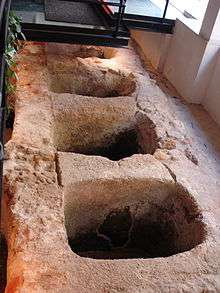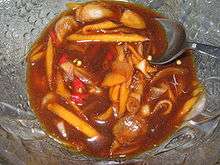Garum

Garum was a fermented fish sauce used as a condiment[1] in the cuisines of ancient Greece, Rome, and Byzantium. Liquamen was a similar preparation, and at times the two were synonymous. Although it enjoyed its greatest popularity in the Roman world, the sauce was earlier used by the Greeks. The Romans thought the Latin word garum derived from the Greek garos, a fish from which it was supposed to have been originally made, but this fish-name is unattested in classical Greek.[2] It is believed to be the ancestor of the fermented anchovy sauce Colatura di Alici which is still produced today in Campania, Italy.[3]
Manufacture

What is called liquamen is thus made: the intestines of fish are thrown into a vessel, and are salted; and small fish, especially atherinae, or small mullets, or maenae, or lycostomi, or any small fish, are all salted in the same manner; and they are seasoned in the sun, and frequently turned; and when they have been seasoned in the heat, the garum is thus taken from them. A small basket of close texture is laid in the vessel filled with the small fish already mentioned, and the garum will flow into the basket; and they take up what has been percolated through the basket, which is called liquamen; and the remainder of the feculence is made into allec.
– Geōponika: Agricultural pursuits, Vol. II, pp. 299-300; translated from the Greek by Thomas Owen; London 1806.
Garum fish paste was prepared from the blood and intestines of fish through the process of autolysis. Fishermen would lay out their catch according to the type and part of the fish, allowing makers to pick the exact ingredients they wanted.[4] The fish parts were then macerated in salt, and cured in the sun for one to three months. The mixture fermented and liquified in the dry warmth, with the salt inhibiting the common agents of decay. Garum was the clear liquid that formed on the top, drawn off by means of a fine strainer inserted into the fermenting vessel. The sediment or sludge that remained was allec.[5] Concentrated decoctions of aromatic herbs might be added. Flavors would vary according to the locale, with ingredients sometimes from in-house gardens.[4][6]
The end product was very nutritious, retaining a high amount of protein and amino acids, along with a good deal of minerals and B vitamins.[7]
Economic role
The manufacture and export of garum was an element of the prosperity of coastal Greek emporia from the Ligurian coast of Gaul to the coast of Hispania Baetica, and perhaps an impetus for Roman penetration of these coastal regions.[8] Amphorae recovered from shipwreck sites off Ansérune and Agde bear the traces of the garum they contained and date as early as the 5th century BC. In the ruins of Pompeii, jars were even found containing kosher garum,[9] suggesting an equal popularity among Roman Jews.
Each port had its own traditional recipe, but by the time of Augustus, Romans considered the best to be garum from Cartagena and Gades in Baetica. This product was called garum sociorum, "garum of the allies".[8] The ruins of a garum factory remain at the Baetian site of Baelo Claudia (in present-day Tarifa) and Carteia (San Roque). Garum was a major export product from Hispania to Rome, and gained the towns a certain amount of prestige. The garum of Lusitania (in present-day Portugal) was also highly prized in Rome, and was shipped directly from the harbour of Lacobriga (Lagos). A former Roman garum factory can be visited in the Baixa area of central Lisbon.[10] Fossae Marianae in southern Gaul, located on the southern tip of present-day France, served as a distribution hub for Western Europe, including Gaul, Germania, and Roman Britain.[11]
Umbricius Scaurus' production of garum was key to the economy of Pompeii. The factories where garum was produced in Pompeii have not been uncovered, perhaps indicating that they lay outside the walls of the city. The production of garum created such unpleasant smells that factories were generally relegated to the outskirts of cities. In 2008, archaeologists used the residue from garum found in containers in Pompeii to confirm the August date of the eruption of Mount Vesuvius. The garum had been made entirely of bogues, fish that congregate in the summer months.[12]
Cuisine
Like the modern fermented soy product soy sauce, fermented garum is rich in the natural amino acid monosodium glutamate, a source of umami flavoring.[14] It was used along with murri to give an umami flavor to dishes.[15]
Garum was produced in various grades consumed by all social classes. After the liquid garum was ladled off of the top of the mixture, the remains of the fish, called allec or alec, was used by the poorest classes to flavour their staple porridge or farinata. The finished product—the nobile garum of Martial's epigram[16]—was apparently mild and subtle in flavor. The best garum fetched extraordinarily high prices,[17] and salt could be substituted for a simpler dish. Garum appears in most of the recipes featured in the Roman cookbook Apicius.
In the 1st century AD, liquamen was a sauce distinct from garum, as indicated throughout the Corpus Inscriptionum Latinarum IV. By the 5th century or earlier, however, liquamen had come to refer to garum.[5] The available evidence suggests that the sauce was typically made by crushing the innards of (fatty) pelagic fishes, particularly anchovies, but also sprats, sardines, mackerel or tuna, and then fermenting them in brine.[18][19][20][21] In most surviving tituli picti inscribed on amphorae, where the fish ingredient is shown, the fish is mackerel.[5]
When mixed with wine (oenogarum, a popular Byzantine sauce), vinegar, black pepper, or oil, garum enhances the flavor of a wide variety of dishes, including boiled veal and steamed mussels, even pear-and-honey soufflé. Diluted with water (hydrogarum) it was distributed to Roman legions. Pliny remarked that it could be diluted to the colour of honey wine and drunk.[22]
Social aspects
The taste for garum had a social dimension that might be compared to an aversion to garlic in some modern Western societies, or to the adoption of fish sauce in Vietnamese cuisine (called nước mắm there).[5] Seneca, holding the old-fashioned line against the expensive craze, cautioned against it, even though his family was from Baetian Corduba:
Do you not realize that garum sociorum, that expensive bloody mass of decayed fish, consumes the stomach with its salted putrefaction?— Seneca, Epistle 95.
A surviving fragment of Plato Comicus speaks of "putrid garum". Martial congratulates a friend on keeping up amorous advances to a girl who had indulged in six helpings of it.[5]
Garum was also employed as a medicine. It was thought to be one of the best cures for many ailments, including dog bites, dysentery, and ulcers, and to ease chronic diarrhea and treat constipation. Garum was even used as an ingredient in cosmetics and for removal of unwanted hair and freckles.[7]
Research by Cambridge University's Piers Mitchell, a biological anthropologist who studies the evolution of disease throughout history, suggests that garum may have helped spread fish tapeworms across Europe.[23]
See also
References
- ↑ (R. Zahn), Real-Encyclopaedia der klassischen Altertumswissenschaft, s.v. "Garum", 1st Series 7 (1912) pp. 841-849.
- ↑ Pliny the Elder, Natural History 31.93; Isidore of Seville, Origines 20.3.19; Thomas H. Corcoran, "Roman Fish Sauces," Classical Journal 58.5 (1963), p. 205, citing D'Arcy W. Thompson, A Glossary of Greek Fishes (London, 1947), p. 43.
- ↑ http://www.npr.org/blogs/thesalt/2013/10/26/240237774/fish-sauce-an-ancient-roman-condiment-rises-again
- 1 2 Curtis, Rober I. 1979. The Garum Shop of Pompeii. Cronache Pompeiane. XXXI. 94. p5-23.
- 1 2 3 4 5 Curtis, Robert I (1983) "In Defense of Garum" The Classical Journal, 78 (3): 232–240.
- ↑ Francesca Lugli,Alessandr a Assunta Stoppiello, Stefano Biagetti. Atti del 4° Convegno Nazionaledi Etnoarcheologia, Roma,17-19 maggio 2006. Rome: ArchaeopressPublishers of British Archaeological ReportsGordon House276 Banbury RoadOxford OX2 7EDEnglan
Atti del 4°
Convegno Nazionaledi Etnoarcheologia, Roma,17-19 maggio 2006
Proceedings of the 4th Italian Congress of Ethnoarchaeology, Rome, 17–19 May 2006
BAR International Series 22352011. p. 70. ISBN 978 1 4073 0797 8. line feed character in
|publisher=at position 105 (help); line feed character in|title=at position 12 (help); Missing|last1=in Authors list (help) - 1 2 Curtis, Robert I. (1984) "Salted Fish Products in Ancient Medicine". Journal of the History of Medicine and Allied Sciences, XXXIX, 4:430-445.
- 1 2 Toussaint-Samat (2009).
- ↑ ,
- ↑ Fundação Millennium bcp Fundação Millennium bcp—Núcleo Arqueológico
- ↑ Curtis, Robert I. 1988. Spanish Trade in Salted Fish Products in the 1st and 2nd Centuries A.D. International Journal of Nautical Archaeology and Underwater Exploration. XXXIX. 205-210.
- ↑ Lorenzi, Rossella Fish Sauce Used to Date Pompeii Eruption
- ↑ G(ari) F(los) SCOM(bri) SCAURI EX OFFI(ci)NA SCAURI, from Pompeii
- ↑ Lewicka, Paulina. Food and Foodways of Medieval Cairenes: Aspects of Life in an Islamic Metropolis of the Eastern Mediterranean. p. 296.
- ↑ Perry, Charles (October 31, 2001), "The Soy Sauce That Wasn't", Los Angeles Times, retrieved 2009-03-21
- ↑ Martial, Epigrams 13.
- ↑ Toussaint-Samat, The History of Food, revised ed. 2009, p. 338f.
- ↑ Curtis RI (2009) "Umami and the foods of classical antiquity" American Journal of Clinical Nutrition, 90 (3): 712S–718S. doi:10.3945/ajcn.2009.27462C
- ↑ Grainger S (2006) "Towards an Authentic Roman Sauce" In: Pages 206–210, Richard Hosking (Ed.) Authenticity in the Kitchen, Proceedings of the Oxford Symposium on Food and Cookery, 2005. ISBN 9781903018477.
- ↑ Jashemski WMF and Meyer FG (2002) The Natural History of Pompeii Cambridge University Press, page 274. ISBN 9780521800549.
- ↑ Zaret, PM (2004) Liquamen and other fish sauces" Repast, 20 (4) : 3–4 and 8.
- ↑ Pliny, Historia Naturalis 13.93.
- ↑ Mitchell, Piers D. (2015) "Human parasites in the Roman World: health consequences of conquering an empire". 'Parasitology (Cambridge Journals), http://journals.cambridge.org/action/displayAbstract?fromPage=online&aid=10083608&fileId=S0031182015001651.
Further reading
- Atik, S. "Marcus Gavius Apicius ve Garum" III-IV. Ulusal Arkeolojik Arastirmalar Sempozyumu, Anadolu / Anatolia Ek Dizi No. 2 / Suppl. Series No. 2, 15–25, Ankara, 2008.
- Butterworth, Alex and Ray Laurence. Pompeii: The Living City. New York, St. Martin's Press, 2005.
- Davidson, James N. (1997) Courtesans and Fishcakes: The Consuming Passions of Classical Athens London: Harper Collins ISBN 9780002555913
- Downie D (2003) "A Roman Anchovy's Tale" Gastronomica - The Journal of Food and Culture, 3 (2).
- McCann, A.M. (1994). "The Roman Port of Cosa",(273 BC), Scientific American, Ancient Cities, pp. 92–99, by Anna Marguerite McCann. Covers: modifying harbor, for the garum industry, amphora factory, hydraulic concrete, of "Pozzolana mortar" and the five piers, of the Cosa harbor, the lighthouse on pier 5, diagrams, and photographs. Height of Port city: 100 BC. For: Garum Industry at port of Cosa, Italy, 273 BC.'
- Smith A.F. (1998) "From Garum to Ketchup. A Spicy Tale of Two Fish Sauces" Pages 299–306 in: Harlan Walker (Ed.) Food from the Waters, Proceedings of the Oxford Symposium on Food and Cookery 1997. ISBN 9780907325895.
- Grant, M. (2008) "Roman Cookery: Ancient Recipes for Modern Kitchens" pp. 26–29 Recipes for garum and vegetarian garum London: Serif ISBN 9781897959602
External links
| Wikimedia Commons has media related to Garum. |
- James Grout: Garum, part of the Encyclopædia Romana
| ||||||||||||||||
| ||||||||||||||||||||||||||||||||||||||||
| ||||||||||||||||||||||||||||||||||||||||||||||||||||||||||||||||||||||||||||||

